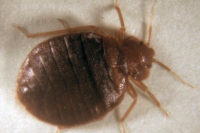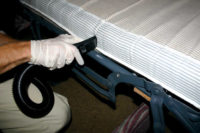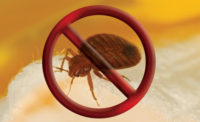They can grow to be as big as 7 millimeters. They’re brown in color and flat with an oval-shaped body. And being that everyone is affected differently from their bites and they’re expert hiders, they can be difficult to detect.
Yes, bed bugs can be a real bugger (pun intended), especially if there’s a failure to detect an infestation while it’s still small and manageable. And that’s why bed bug remediation – especially after the national bed bug boom of 2010 – is becoming a more popular add-on service among restoration professionals, especially those who are already into bio-hazard, hoarding and trauma cleaning.
“Bed bug control can kind of be seen as a niche type thing – there are a lot of companies that are just going into bed bug remediation,” says Jeff White, an entomologist and Technical Director at Bed Bug Central, a training and information resource. “You can go into bed bugs and do perfectly well if you’re in a big enough city and area that has an issue. I think that’s why a lot of people have gravitated towards it.”
One of those restoration companies is Allied Services (Chicago, IL), who began doing bed bug work in 2008 when a customer approached them about a project. After noting that there was opportunity in the Chicago area for such a service, Allied Services got the necessary training from Bed Bug Central’s Bed Bug University education program and have been performing the service ever since. In fact, today Dan Wondaal, Allied Services VP of Operations, says bed bug work is running 90% of the business.
“We’ve grown leaps and bounds,” says Wondaal. “When we first started bed bugs, we were an eight-man shop, give or take. Right now, we’re in the low 50’s.”
So just how profitable can bed bug work be? According to White, an average two-bedroom apartment would likely cost $1,000 to $1,200 to service. A single-family home could cost between $3,000 and $5,000. More serious infestations, such as those that have spread throughout a multi-family or apartment complex, can carry a price tag of up to $20,000.
However, while your eyes might be lighting up with dollar signs, there’s a lot more to consider before adding bed bug remediation to your business.
Can Your Service Market Support It?
“Bed bugs get a lot of attention from the media because people think they’re creepy,” White says. “So a lot of times, you can have a huge stir around bed bugs because the media got a hold of a story and it can seem like more of a problem in an area than it actually is. So you want to try to get as good of a feel as you can for what the problem really truly is.”
Bed bugs go where people go, so cities tend to be greater hotspots than rural areas, as Wondaal discovered. While bed bug infestations can crop up anywhere, Allied Services does the bulk of its business in multi-family housing complexes, senior citizen housing and assisted living centers. Allied has also expanded into Indiana and southern Wisconsin.
The Technology: Chemicals vs. Heat
There are two popular techniques that can both effectively kill bed bugs – the traditional approach of chemicals and heat treatment. Both techniques have their pros and cons.
According to White, heat treatments are best completed with whole house heating structures, as temperatures of 120° F and greater over the course of several hours are needed to kill off bed bugs and their eggs. Heat treatments can also be advantageous for restoration and remediation professionals going into this service area, as many are already likely to be working with thermal remediation units.
“Heat, in most infestations, you may be able to eliminate in one day,” White says. “But the heat approach can cost 50% more than the traditional approach.”
Chemicals and pesticides is the other approach. (Note: In order to administer pesticides, you need to have the proper licensing.) It typically takes longer to kill the infestation – White estimates two to three treatments over the course of a month – but it’s a cheaper option that can be combined with other equipment, like bed bug-trapping bed encasements and interception devices, to become more effective.
“The bottom line is that you’re not just relying on pesticides, but you’re incorporating other devices into the actual control program,” White says. “It can be a very effective approach if done properly.”
Finally, there’s a hybrid sort of approach that combines chemicals and heat, which is what Allied Services typically implements. In extreme infestations, thermal remediation units to treat the entire house are used. However, in more isolated cases, the team uses portable steamers to kill the bugs.
“One of the things that does kind of separate our heat process is that it does involve chemicals,” Wondaal says. “When you’re dealing with adults, chemicals are a lot more effective, so you have that residual treatment. As far as eggs go, eggs are very difficult to kill and heat is the best option.”
Identifying Bed Bug Problems
Although bed bugs are small, they are visible to the naked eye. But what makes them difficult to detect is that they’re expert hiders. During the day, they’re hidden away in your piping seams and mattress tags, in your box spring and in the cracks of the frame and head board. Throw in the fact that everyone reacts differently to a bed bug bite (symptoms, if even noticeable, sometimes won’t become visible for up to two weeks), and bed bug infestations can be hard to detect, which is part of how they’re able to spiral out of control so quickly.
Anyone can spot a high-level infestation, but it’s often difficult to detect where exactly the bed bugs are making camp on a low-level infestation. That’s where Allied Services’ 20 bed bug sniffing dogs come in handy.
“On a low-level infestation, a visual inspection, even with the best-trained technicians, you’re probably running 40 to 50% accuracy at best,” Wondaal says. “With a properly trained canine, you can be 88 to 92% effective. The other thing (dogs) allow us to do, which is very beneficial, is to focus our treatment a lot more. It narrows down our scope of work a lot.
“The other thing is the speed and time they can do that inspection. If I had to inspect a one-bedroom apartment thoroughly to find a low-level infestation, it could take me a couple of hours. A canine can get through that inspection in three to five minutes.”








Report Abusive Comment